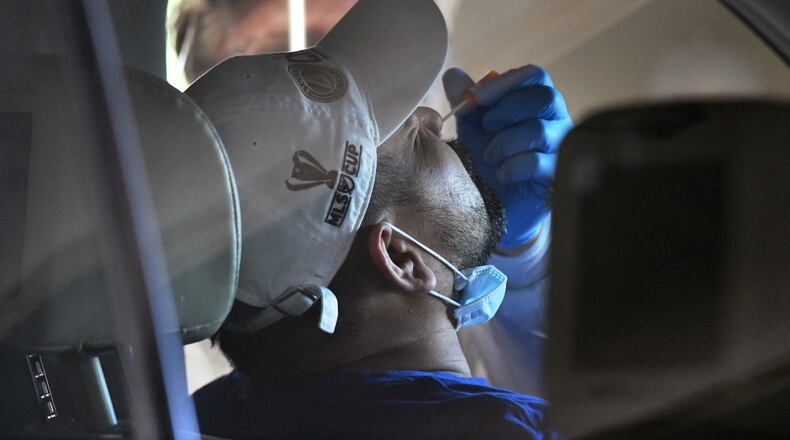Gwinnett County’s diagnosed coronavirus cases are most concentrated on its east side, health department data shows, but its health officials say they are being cautious about interpreting the numbers.
The highest diagnosis rates are in two ZIP codes covering parts of Lilburn, Lawrenceville, Buford and Braselton. Both of those ZIP codes had rates of 3 or more cases diagnosed per 1,000 people. The five others with rates higher than 2.4 diagnoses per 1,000 people are all in southeast Gwinnett County, covering parts of Lawrenceville, Lilburn, Norcross, Snellville and Grayson.
MORE | Metro Atlanta leaders left to make COVID-19 decisions with shaky data
It’s hard to draw conclusions from the diagnosis data recorded since March, according to Dr. Audrey Arona, health director of the Gwinnett, Newton and Rockdale County Health Department.
“Our data is very highly skewed because we were not testing a broad part of the population for a long time,” Arona said. “Now that we’ve opened up to the whole community, we’re testing more asymptomatic people. When you change the population in which you’re testing, it’s very hard to correlate percentages.”
When testing began in March, only healthcare workers, law enforcement, people over the age of 65 and people who worked or lived in a long-term care home could get tested. Then, in mid-April, testing was opened to anyone with symptoms. Now, anyone can get tested regardless whether they’re symptomatic.
ZIP code 30044, which includes parts of Lawrenceville and Lilburn, had a diagnosis rate of 3.5 cases per 1,000 people on May 11, according to data from the Gwinnett, Newton and Rockdale County Health Department. That ZIP code has a population that is 26% white, 25% black, 12% Asian and 34% Hispanic or Latino, according to U.S. Census Data from 2018. Residents in 30044 have a median household income of $61,130 and 12% of people live below the poverty line, according to the census.
In ZIP code 30519, sandwiched between I-85 and I-985, there was a diagnosis rate of 3.4 cases per 1,000 people. 61% of residents are white, 18% are black, 9% are Asian and 10% are Hispanic or Latino, according to census data from 2018. The median household income in 30519, which includes parts of Buford and Braselton, is $82,113 and 4.8% of residents are below the poverty line.
Higher rates in certain areas could be partially explained by population and household size — more multigenerational homes and densely populated places could facilitate higher transmission rates, Arona said. The locations of long-term care facilities like retirement homes, where the virus poses a particular risk to seniors and people with underlying health conditions, could also raise an area’s incidence rate, Arona said.
“As we learn about this virus and more statistics are given to us, over time, we’ll be able to make assessments in real time and less assumptions,” Arona said.
While national data has pointed to COVID-19 disproportionately affecting African Americans, the Gwinnett, Newton and Rockdale county numbers don’t reflect that on their face. Across the three counties, 26% of cases were diagnosed in black patients and 27% in white patients. The three counties’ populations combined are 33.2% black and 52.7% white. White patients did make up a larger portion of the 112 deaths in the health district, with 56% of the dead being white. The health department’s demographic breakdown only includes black, white, “other race” and “unknown race,” so it is difficult to determine how exactly communities including Asian Americans and Latinos have been impacted.
Arona gave the same warning about the accuracy of the data when discussing how the virus has impacted different racial and ethnic groups.
The Gwinnett Newton and Rockdale County Health Department keeps data on coronavirus diagnoses on its website, where it is updated every Tuesday. Click here to find the latest information.
About the Author
Keep Reading
The Latest
Featured

